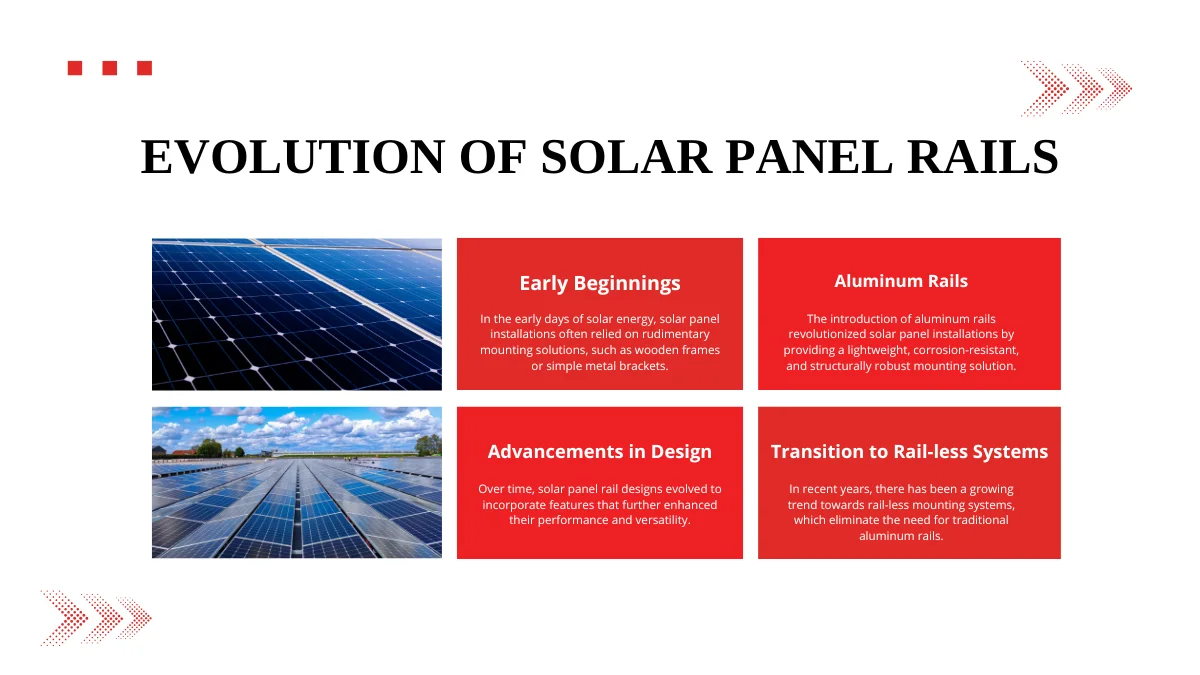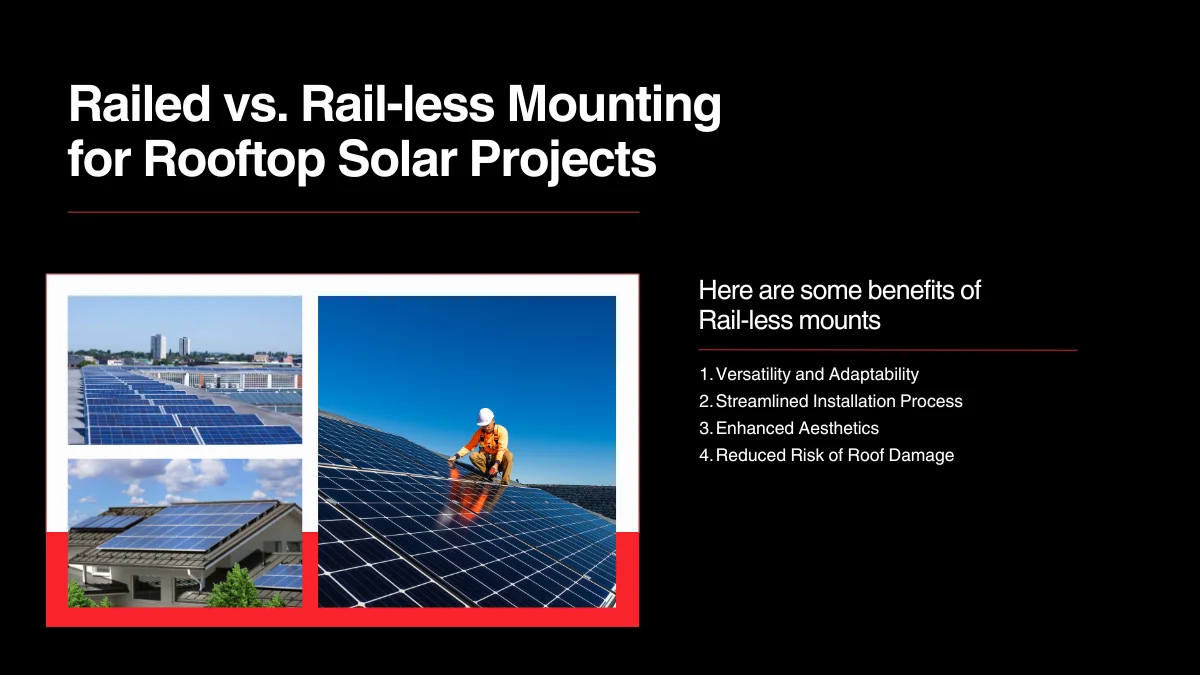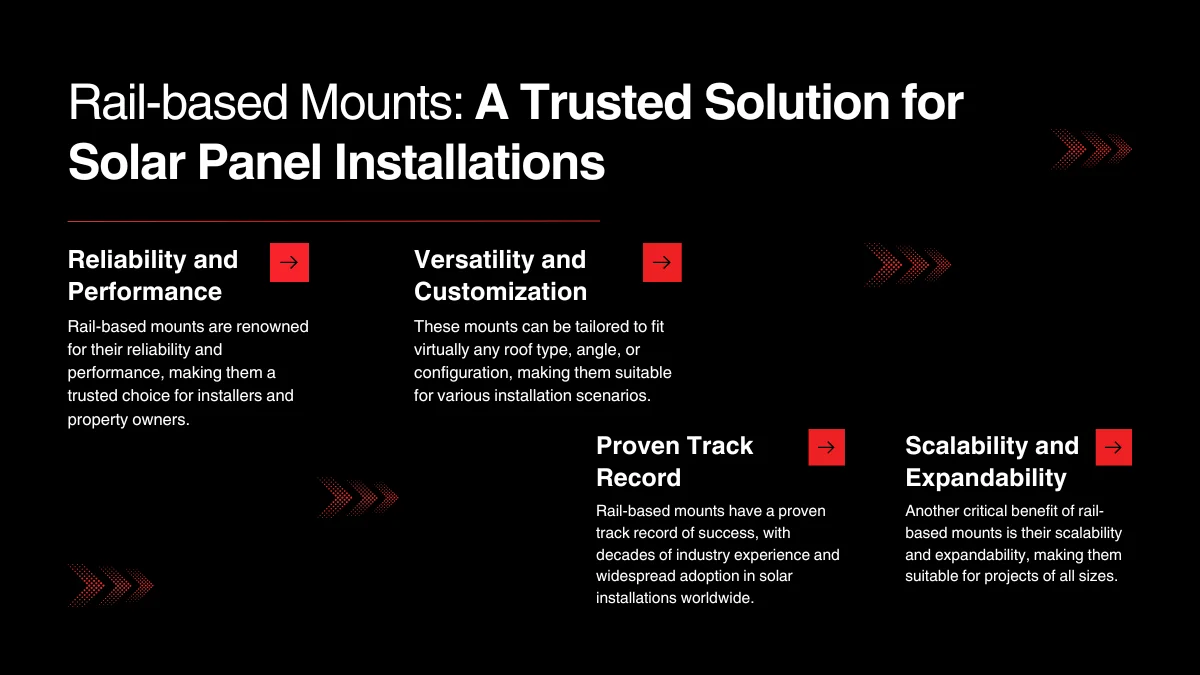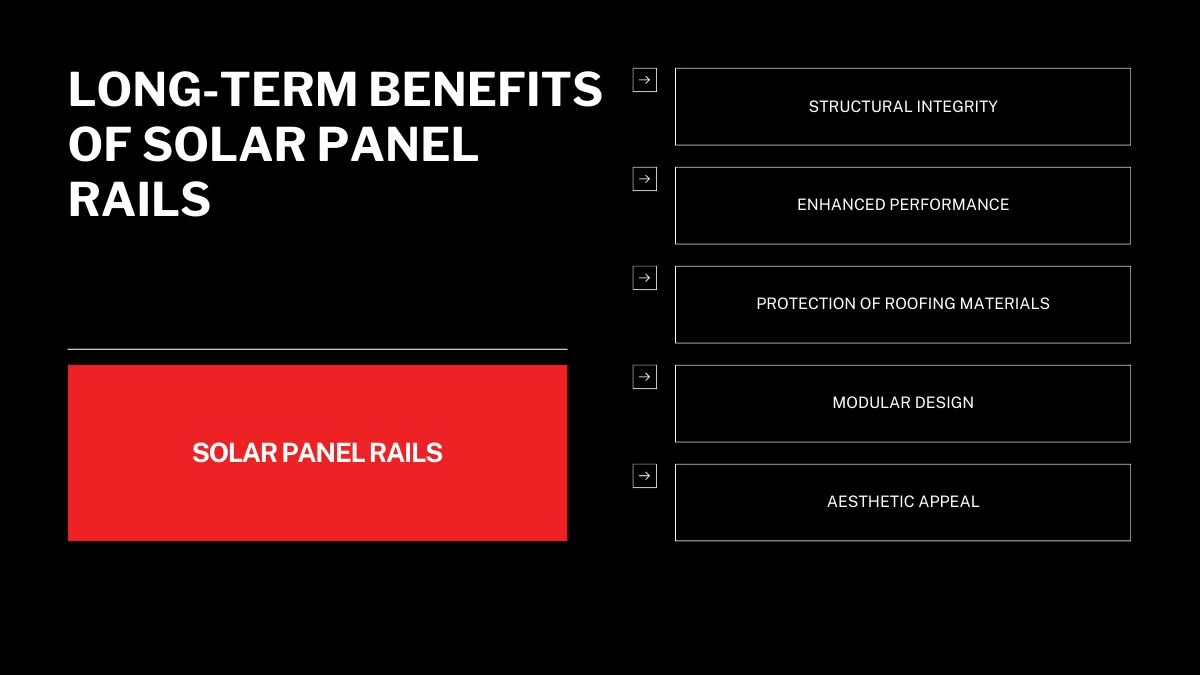Installation to Long-Term Benefits
The solar energy industry has undergone remarkable transformations in recent years, propelled by technological advancements and innovative approaches to harnessing the sun's power. The solar panel rail system is central to these advancements, a critical component that forms the backbone of solar panel installations. As the demand for clean and sustainable energy continues to soar, the evolution of solar panel rails has played a pivotal role in shaping solar energy systems' efficiency, reliability, and versatility.
This blog delves into the evolution of solar panel rails, comparing railed versus rail-less mounting systems and exploring the long-term benefits of each.
Evolution of Solar Panel Rails

The evolution of solar panel rails represents a fascinating journey of innovation and adaptation within the solar industry. From their inception as rudimentary support structures to their current state as sophisticated engineering marvels, solar panel rails have adapted remarkably to the changing demands of solar installations.
- Early Beginnings
In the early days of solar energy, solar panel installations often relied on rudimentary mounting solutions, such as wooden frames or simple metal brackets. These early mounting systems lacked the sophistication and durability required for long-term solar installations, posing challenges in stability, weather resistance, and overall performance.
- Introduction of Aluminum Rails
The introduction of aluminum rails revolutionized solar panel installations by providing a lightweight, corrosion-resistant, and structurally robust mounting solution. Aluminum rails offered greater flexibility and ease of installation than traditional mounting methods, allowing for more efficient and reliable solar arrays.
- Advancements in Design
Over time, solar panel rail designs evolved to incorporate features that further enhanced their performance and versatility. Manufacturers introduced adjustable rail systems that allowed for precise positioning of solar panels to maximize sun exposure and energy production. Additionally, integrated wire management solutions were developed to streamline installation and improve the overall aesthetics of solar arrays.
- Transition to Rail-less Systems
In recent years, there has been a growing trend towards rail-less mounting systems, which eliminate the need for traditional aluminum rails. Rail-less systems utilize innovative clamping mechanisms and mounting hardware to secure solar panels directly to the mounting surface, offering benefits such as reduced material costs, simplified installation processes, and improved aesthetics.
Railed vs. Rail-less Mounting for Rooftop Solar Projects
Rail-less mounts represent a groundbreaking advancement in solar panel installations. They depart from traditional railed systems and introduce a host of benefits for installers and property owners alike.

Traditionally, solar panel installations utilized railed mounting systems, which involved securing panels to horizontal rails mounted on rooftops. While railed systems provided stability and ease of installation, they often required more time and labor due to the need for precise rail alignment and attachment.
Here are some benefits of Rail-less mounts
- 1. Versatility and Adaptability
Rail-less mounts offer unparalleled versatility and adaptability, making them suitable for various installation scenarios. Unlike traditional railed systems, which often require precise measurements and customization to fit specific roof types and configurations, rail-less mounts can be easily adjusted and tailored to accommodate various roof angles, shapes, and materials. This versatility simplifies the installation process and allows for greater flexibility in system design, enabling installers to navigate complex roof layouts easily.
- 2. Streamlined Installation Process
One of the most significant advantages of rail-less mounts is their streamlined installation process. By eliminating the need for rails, these mounts reduce the components and steps involved in the installation, resulting in faster and more efficient project completion. Installers can spend less time on-site and minimize labor costs, making rail-less mounts an attractive option for residential and commercial projects.
- 3. Enhanced Aesthetics
Rail-less mounts offer a sleek and minimalist aesthetic that enhances the overall appearance of solar panel installations. Without bulky rails cluttering the roofline, rail-less systems create a cleaner and more seamless look that blends seamlessly with the building's architecture. This aesthetic appeal is particularly appealing for residential installations, where homeowners place a premium on the visual harmony between their solar arrays and the design of their homes.
- 4. Reduced Risk of Roof Damage
Traditional railed systems often require roof penetrations to secure the rails in place, which can increase the risk of water leakage and structural damage over time. In contrast, rail-less mounts minimize the need for roof penetrations, reducing the potential for leaks and preserving the roof's integrity. This can lead to long-term cost savings and peace of mind for property owners, knowing that their roof is protected from damage caused by solar panel installations.
Rail-based Mounts: A Trusted Solution for Solar Panel Installations
Rail-based mounts have long been a staple in the solar industry. They offer reliability, durability, and versatility for a wide range of installation scenarios. Here, we delve into the key benefits of rail-based mounts, highlighting their enduring appeal and suitability for various applications.

- 1.Reliability and Performance
Rail-based mounts are renowned for their reliability and performance, making them a trusted choice for installers and property owners. These mounts are engineered to withstand the rigors of outdoor environments, providing secure support for solar panels in all weather conditions. With durable materials and robust construction, rail-based mounts offer peace of mind, knowing solar arrays are securely anchored and protected against wind, snow, and other environmental factors.
- 2. Versatility and Customization
These mounts can be tailored to fit virtually any roof type, angle, or configuration, making them suitable for various installation scenarios. Installers can adjust the mounting system to accommodate specific project requirements, whether it involves complex roof layouts, varying panel sizes, or unique architectural features. With adjustable components and modular designs, rail-based mounts offer endless possibilities for customization, ensuring optimal performance and compatibility with different solar panel configurations.
- 3. Proven Track Record
Rail-based mounts have a proven track record of success, with decades of industry experience and widespread adoption in solar installations worldwide. Manufacturers have refined and perfected rail-based mounting systems over the years, incorporating feedback from installers and innovations to improve efficiency, durability, and ease of installation. As a result, rail-based mounts offer a reliable and time-tested solution for solar panel installations backed by industry-leading warranties and customer support.
- 4. Scalability and Expandability
Another critical benefit of rail-based mounts is their scalability and expandability, making them suitable for projects of all sizes. Whether it's a small residential installation or a large-scale commercial or utility project, rail-based mounts can be easily scaled to meet the demands of the application. Installers can add or remove rail sections as needed, accommodating system size or configuration changes without compromising structural integrity or performance. This scalability ensures that rail-based mounting systems can grow and adapt alongside evolving energy needs, providing long-term value and flexibility for property owners.
Long-Term Benefits of Solar Panel Rails
While the immediate focus of solar panel installations often revolves around efficiency and cost-effectiveness, it's essential to consider the long-term benefits that solar panel rails can offer. Here are some key advantages that extend beyond the initial installation:

- 1. Structural Integrity:
Solar panel rails provide structural support for the entire solar array, ensuring stability and durability over the long term. By securely anchoring the panels to the mounting surface, rails help withstand environmental stresses such as wind, snow, and seismic activity, protecting the integrity of the installation for years to come.
- 2. Enhanced Performance:
Properly installed solar panel rails help optimize the performance of the solar panels by ensuring they are positioned at the optimal angle and orientation to capture sunlight effectively. By maximizing sun exposure throughout the day, rails increase energy production and overall system efficiency over the installation's lifetime.
- 3. Protection of Roofing Materials:
Solar panel rails act as a protective barrier between the solar panels and the underlying roofing materials, preventing direct contact and minimizing the risk of damage. By distributing the weight of the panels evenly across the mounting surface, rails help alleviate stress on the roof structure, reducing the potential for leaks, cracks, and premature deterioration.
- 4. Modular Design:
Many solar panel rail systems feature a modular design, allowing easy scalability and expansion as energy needs evolve. This flexibility enables homeowners and businesses to add additional panels to their existing arrays or upgrade to more efficient solar technologies without extensive modifications to the mounting infrastructure.
- 5. Aesthetic Appeal:
Beyond their functional benefits, solar panel rails can also contribute to the overall aesthetic appeal of a solar installation. Well-designed rail systems complement the building's architecture and create a polished, professional appearance. For residential installations, visually appealing rail designs can enhance curb appeal and increase property value.
Conclusion
The evolution of solar panel rail systems has brought significant advancements in solar arrays' installation and long-term performance. Whether opting for rail-less or rail-based mounts, understanding the benefits and challenges of each system is crucial for making an informed decision. As the solar industry continues to innovate, Unimacts is the industry leader making sure their mounting systems will play a vital role in driving the adoption of clean, renewable energy.
Contact our experts to understand how our solar panel systems can guarantee durability and success for your installation needs.


